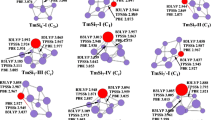Abstract
Computations using standard time dependent DFT (B3LYP/6-31G) can neither reproduce experimental CD spectra of optically active tris(2,4-pentanedionato)silicon(IV), [Si(acac)3]+, nor the CD of a series of similar coordination compounds of Si(IV). These compounds are characterized by exciton coupled ligand transitions which are not influenced by orbitals on the central ion. We have found that TD DFT calculations using long range functionals can indeed reproduce the measured CD satisfactorily. The detailed interpretations make use of D3 point group symmetry and symmetry adapted excited state functions allowing for the electronic coupling of the excitation of the ligands. Computations of similar problems for transition metal ions coordinated to rigid π systems are common and probably also sensitive to the choice of functional.









Similar content being viewed by others
References
Larsen, E., Mason, S.F., Searle, G.H.: Absorption and circular dichroism spectra and absolute configuration of tris acetylacetonato silicon(IV) ion. Acta Chem. Scand. 20, 191–196 (1966)
Dhar, S.K., Doron, V., Kirschner, S.: 6-Coordinate silicon(IV).2. The hydrolysis and racemization of the tris-(acetylacetonato)-silicon(IV) cation. J. Am. Chem. Soc. 81, 6372–6375 (1959)
Ito, T., Tanaka, N., Hanazaki, I., Nagakura, S.: Absolute configuration and polarization of the ligand π* ← π transition of the tris(tropolonato)silicon(IV) ion. Inorg. Nucl. Chem. Lett. 5, 781–782 (1969)
Adam, K.R., Atkinson, I.M., Lindoy, L.F.: Local density functional theory analysis of the structures and energies of the isomers of low-spin [Ni(cyclam)]2+. Inorg. Chem. 36, 480–481 (1997)
Hambley T, Lindoy, L.F., Reimers, J.R., Turner, P., Wei, G., Widmer-Cooper, A.N.: Macrocyclic ligand design. X-Ray, DFT and solution studies of the effect of N-methylation an N-benzylation of 1,4,10,13-tetraoxa-7,16-diazacyclooctadecane on its affinity ofor selected transition and post-transition metal ions. Dalton Trans., 614–620 (2001)
Heine, K.B., Clegg, J.K., Heine, A., Gloe, K., Henle, T., Bernhardt, G., Cai, Z.-L., Reimers, J.R., Lindoy, L.F., Lach, J., Kersting, B.: Complexation, computational, magnetic, and structural studies of the Maillard reaction product isomaltol including investigation of an uncommon πi interaction with copper(II). Inorg. Chem. 50, 1498–1505 (2011)
Kapinos L.E., Operschall, B.P., Larsen, E., Sigel, H., Understanding the acid–base properties of adenosine. The intrinsic basicities of N1, N3, and N7. Eur. J. Chem. (2011). doi:10.1002/chem.201003544
Thulstrup P.N., Broge L., Larsen E., Springborg J.: On the electronic structure and spectroscopic properties of a pseudo-tetrahedral cationic cobalt(II) tetraamine complex—([3(5)]adamanzane)cobalt(II). Dalton Trans., 3199–3204 (2003)
Thulstrup P.W., Larsen E.: The electronic structure and spectra of spin-triplet ground state bis(biuretato)cobalt(III) coordination compounds. Dalton Trans.,1784–1789 (2006)
Diedrich, C., Grimme, S.: Systematic investigation of modern quantum chemical methods to predict electronic circular dichroism spectra. J. Phys. Chem. A 107, 2524 (2003)
Frisch, M.J., Trucks, G.W., Schlegel, H.B., Scuseria, G.E., Robb, M.A., Cheeseman, J.R., Scalmani, G., Barone, V., Mennucci, B., Petersson, G.A., Nakatsuji, H., Caricato, M., Li, X., Hratchian, H.P., Izmaylov, A.F., Bloino, J., Zheng, G., Sonnenberg, J.L., Hada, M., Ehara, M., Toyota, K., Fukuda, R., Hasegawa, J., Ishida, M., Nakajima, T., Honda, Y., Kitao, O., Nakai, H., Vreven, T., Montgomery Jr., J.A., Peralta, J.E., Ogliaro, F., Bearpark, M., Heyd, J.J., Brothers, E., Kudin, K.N., Staroverov, V.N., Kobayashi, R., Normand, J., Raghavachari, K., Rendell, A., Burant, J.C., Iyengar, S.S., Tomasi, J., Cossi, M., Rega, N., Millam, J.M., Klene, M., Knox, J.E., Cross, J.B., Bakken, V., Adamo, C., Jaramillo, J., Gomperts, R., Stratmann, R.E., Yazyev, O., Austin, A.J., Cammi, R., Pomelli, C., Ochterski, J.W., Martin, R.L., Morokuma, K., Zakrzewski, V.G., Voth, G.A., Salvador, P., Dannenberg, J.J., Dapprich, S., Daniels, A.D., Farkas, O., Foresman, J.B., Ortiz, J.V., Cioslowski, J., Fox, D.J.: Gaussian 09, Revision B.01. Gaussian, Inc., Wallingford, CT (2010)
Harnung, S.E., Ong, E.C., Weigang, O.E.: Low-resolution analysis of vibrational-electronic circular dichroism spectra. J. Chem. Phys. 55, 5711–5724 (1971)
IUPAC: Nomenclature of Inorganic Chemistry. RCS Publishing Cambridge, Cambridge (2005)
Orgel, L.E.: Double bonding in chelated metal complexes. J. Chem. Soc., 3683–3686 (1961)
Dilthey, W.: Über Siliciumverbindungen. Berichte 36, 923–930 (1903)
Fan, J., Seth, M., Autschbach, J., Ziegler, T.: Circular dichroism of trigonal dihedral chromium(III) complexes: a theoretical study based on open-shell time-dependent density functional theory. Inorg. Chem. 47, 11656–11668 (2008)
Goerigk, L., Stefan, G.: Calculation of electronic CD spectra with time-dependent double-hybrid density functional theory. J. Phys. Chem. A 113, 767–776 (2009)
Liu, H.L., Ohmori, Y., Kojima, M., Yoshikawa, Y.: Stereochemistry of six-coordinate octahedral silicon(IV) complexes containing 2,2′-bipyridine. J. Coord. Chem. 44, 257–268 (1998)
Fan, J., Autschbach, J., Ziegler, T.: Electronic structure and circular dichroism of tris(bipyridyl) metal complexes within DFT. Inorg. Chem. 49, 1355–1362 (2010)
Fan, J., Ziegler, T.: On the origin of circular dichroism in trigonal dihedral cobalt (III) complexes of unsaturated bidentate Ligands. Inorg. Chem. 47, 4762–4773 (2008)
Kojima, M., Azuma, S., Hirotsu, M., Nakajima, K, Nanoyama, M., Yoshikawa, Y.: Optical Resolution of a six-coordinate silicon(IV) complex with a tripod hexadentate ligand. Chem. Lett. 482–483 (2000)
Acknowledgments
We wish to thank University of Copenhagen for giving us working conditions for this project.
Author information
Authors and Affiliations
Corresponding author
Additional information
Dedicated to Professor Leonard F. Lindoy, a pioneer of macrocyclic and supramolecular chemisttry, on the occasion of his 75th birthday.
Rights and permissions
About this article
Cite this article
Harnung, S.E., Larsen, E. TD-DFT computations for trigonal silicon(IV) coordination compounds of rigid bidentates. J Incl Phenom Macrocycl Chem 71, 419–428 (2011). https://doi.org/10.1007/s10847-011-9976-8
Received:
Accepted:
Published:
Issue Date:
DOI: https://doi.org/10.1007/s10847-011-9976-8




